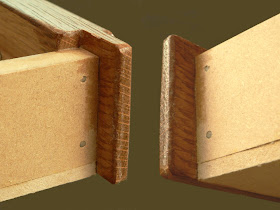For many years, I've spent vacation time combing beaches, river beds, hills, gravels, roadsides, parking lots, and other spots for interesting and representative stones. Combined with occasional purchases from rock shops and other specimens acquired through rock and mineral clubs, this had resulted in my having acquired a good volume of material to identify, compare, and organize. In no way a collection of much value from a financial point of view, but extremely interesting.
However, I had one persistent problem: the collection was stored in egg-cartons and in boxes of various sizes in a back corner of the basement. Too often I had lost track of locations of origin, or in some cases, of rock and mineral identifications. (I mention all this because I think I'm not alone). For twenty years I had been contemplating building a storage cabinet, and I was beginning to doubt that I would ever get around to it.
A few years ago, I decided to tackle the project. I designed and built two cabinets which together have a capacity of approximately 4000 specimens, and which now hold most of my collection. Here I'm sharing my experience for the benefit of other collectors who might have similar storage and display needs.
Two cabinets with a total of 30 drawers allow storage for 4000 rock and mineral specimens.
My primary interests are in identifying rocks and minerals, and in understanding the processes by which these were created. My collection also includes quite a few fossils and petrified woods, various slabs, some gemstones, and a few cabochons. The cabinets I built are for both storage and display - with good lighting, specimens in open drawers can look stunning, and similarities and contrasts with their neighbors will be revealed.
The storage solution described here does not aim to replace wall-mounted shelves, illuminated cabinets, or display stands for exhibiting large mineral and fossil specimens. I'm not a big crystal collector - for me, the ideal is usually sub-egg size. The cabinets will handle these and also larger specimens provided that they are not too high. I don't have many really large pieces, and those which I do have mostly fall under the category of "big rocks" and are best placed around the pond.
This cabinet design best suits miniature specimens (sub-egg size), and other flat or low specimens.
Although the two 15-drawer cabinets I built are fairly large, it was not a difficult project – more a matter of repetition, because of the number of drawers. This project is within the reach of a woodworker of moderate skills. The cabinets are built with simple box construction, and the drawers are fairly simple also - a few rabbets, but otherwise just nailed and glued together and supported by drawer runners.
However, it is a tablesaw project. If you don’t have the tools or the skills, you’ll need a family member, friend, or cabinetmaker to take on the construction.
Here are two views of the joints at the drawer front, one from above, and one from below. Drawer runners (not shown) support the drawer bottom and provide both smooth gliding and easy removal.
My objectives here are to provide guidance in aspects of design, construction, and use. If you decide to work with this design, you’ll likely want to change the number of drawers and their size to suit your own needs. And there are other factors that will influence your own approach. These are covered in the next topic, Designing the Cabinet – What to Consider. Understanding the choices I made and the reasons for them might help you to make your decisions. I’ll also mention some things I didn’t do, but which might be useful to you.
Then in Tips for Building the Cabinet and Drawers, I’ll provide practical guidance for constructing the cabinet case and drawers.
Finally, under Using the Storage and Display Cabinet, I’ll discuss physical considerations and an approach to organizing and cataloging the collection.


